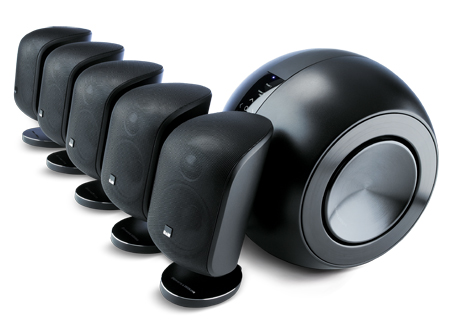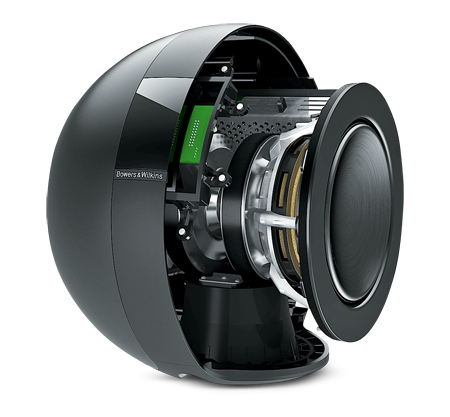 |
| image credit: Bowers & Wilkins |
The B&W Mini Theater has won an Award in various versions since its launch, and the absence of a new model at the end of last year came as a surprise to us.
But now, finally, he is in our hands. The kit is renamed MT-60D due to the updated PV1 subwoofer equipped with a digital processor (DSP) called PV1D. Satellites M-1 inside are also completely redesigned, despite the name remaining the same and almost imperceptible external changes.
All operations for the creation of M-1 and PV1D are now carried out by the company at its own facilities in the UK. The new M-1 tweeter is based on Nautilus high-end tube-loaded drivers; The midrange/woofer is now equipped with an anti-resonant bullet splitter pioneered in the PM1 series.
The updated Ml provide radiation in a wider frequency range and limit low frequencies at a lower point, which not only improves the quality of integration with the subwoofer but also allows them to be used as part of a stereo system. Other changes include a new crossover, cleaner terminals, increased structural strength, and quality finish on the built-in stands. Wall mounts included; floor stands will have to be purchased separately. B&W is proud of the changes to the PV1D subwoofer; details of the technology are in the sidebar on the right.
Best to hang on the wall
Satellites sound best when in close contact with a wall; Bowers & Wilkins recommends wall-mounted placement, which is something to keep in mind when planning your purchase. After properly warming up, you will hear the familiar B&W sound ... but not quite familiar: it just got better.
The Warrior on Blu-ray keeps the viewer in suspense from the very first frames, and the MT-60D perfectly conveys its dynamics and aggressiveness thanks to the enhanced bass quality. Not only are the bass more powerful, but the treble also has more vitality, and they sound even more wonderful.
Delightfully detailed sound
Both dialogues and harsh sounds (for example, the sound of breaking glass) have become even clearer and clearer. The detail is almost perfect both in the episodes of powerful explosions, brilliantly controlled by a powerful subwoofer and at the frontal borders of sharp sounds, in the creation of which the satellites take the lion's share. True, the enthusiasm at times overflows, so you should be more careful when choosing a system: avoid receivers with a too bright character.
Despite the relatively small dimensions of the speakers, the soundtracks sound very large and impressive, the effects are convincingly and accurately distributed over the sound field. The junction between the satellites and the subwoofer is practically indistinguishable - this is as it should be, but it does not always work out.
The B&W PR people did not deceive: the music is performed splendidly both in multichannel mode and in stereo. Fast and agile, Swoon Chemical Brothers delights with explosive expressiveness and dynamics while maintaining complete control. James Vincent McMorrow's more subtle cover of Higher Love demonstrates the detail and texture of the voice.
We've been waiting for the new B&W for a long time, but it was worth it: these speakers are truly versatile, they masterfully handle 5.1-channel tracks, are incredibly good in stereo, well-made, and not capricious in installation. They fully justify all the magnificent epithets.
 |
| image credit: Bowers & Wilkins |
"D" stands for "digital"
The first version of the PV1 not only completely changed the way we think about subwoofers, but also gave B&W 5.1-channel systems a huge advantage: no equivalent subwoofer could match it in terms of mobility, power, bass speed, and dynamics. The PV1D combines the impeccable performance of the PV1 with the digital audio technology developed for the flagship DB1 subwoofer. Other external changes include an OLED display with touch controls. Power is now 400 watts instead of the previous 500, but B&W promises that the higher efficiency will compensate for the lower power; indeed, it sounds lower and louder than before.
Several equalizer modes will allow you to more detailed approach to the setting. Sets of its parameters can be changed and saved as presets; there are also B&W recommended options. But even if you do not go into details and rely on the will of the AV receiver, the sound will still be magical.
"PV" stands for "pressure vessel" - refers to the metal body. The round shape allows the mechanical stress to be evenly distributed.
PV1D has two opposing speakers; in this configuration, their vibrations are mutually suppressed, which improves sound clarity and reduces energy consumption.
B&W PV1D - SPECIFICATIONS
| Technical features | Paper-Kevlar®/aluminium composite diaphragm drivers Balanced drive Digital Signal Processing 400W Class-D amplifier |
| Drive units | 2x 200mm (8in) Paper-Kevlar®/aluminium cone long-throw |
| Frequency response* | -6dB at 6.5Hz and 570Hz |
| Frequency response* | 7.5Hz - 450Hz ±3dB on reference axis |
| Amplifier | Power output: 400W Rated power consumption: 150W Standby power consumption: <1W Input impedance: 100kΩ Signal/noise: >100dB |
| Functions | 5 presets Input sensitivity (analogue) Gain (digital) Low-pass filter: frequency, slope, phase Auto on/standby 12V trigger on/standby 12V trigger preset switching RS-232 automation contro |
| Inputs | Stereo line in (2x RCA/Phono/Cinch) Speaker level in (5m cable supplied) |
| Dimensions | Height: 342mm (13.5in) Width: 270mm (10.6in) Depth: 358mm (14.1in) |
| Net weight | 18.7kg (41lb) |
B&W M-1 - SPECIFICATIONS
| Technical features | Nautilus™ tube loaded tweeter with aluminum dome Woven glass fiber cone bass/midrange |
| Drive Units | 1x 25mm (1in) aluminum dome high-frequency 1x 100mm (4in) woven glass fiber cone bass/midrange |
| Frequency range | 6dB at 55Hz and 50kHz |
| Frequency response | 64Hz - 23kHz ±3dB on reference axis |
| Dispersion | Within 2dB of reference response Horizontal: over 60° arc Vertical: over 10° arc |
| Sensitivity | 85dB SPL (2.83V, 1m) |
| Harmonic distortion | 2nd and 3rd harmonics (90dB, 1m) <1% 120Hz - 30kHz |
| Nominal impedance | 8Ω (minimum 4.0Ω) |
| Crossover frequency | 4kHz |
| Recommended amplifier power | 20W - 100W into 8Ω on unclipped program |
| Max. recommended cable impedance | 0.1Ω |
| Dimensions | Height: 248mm (9.8in) Width: 114mm (4.5in) Depth: 162mm (6.4in) Mounted on a table stand |
| Net weight | 2.3kg (5lb) |









.jpg)


.jpg)



0 Comments